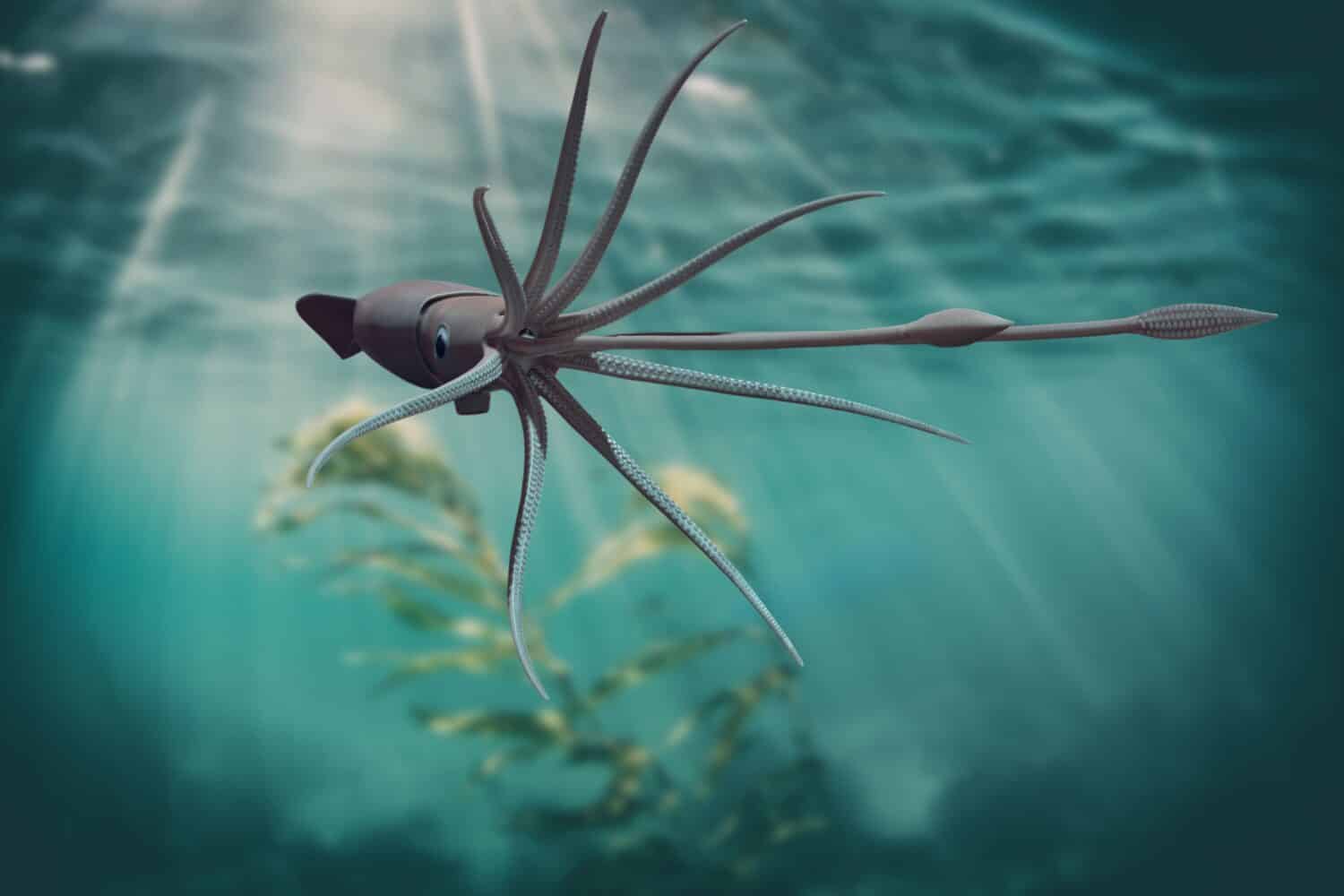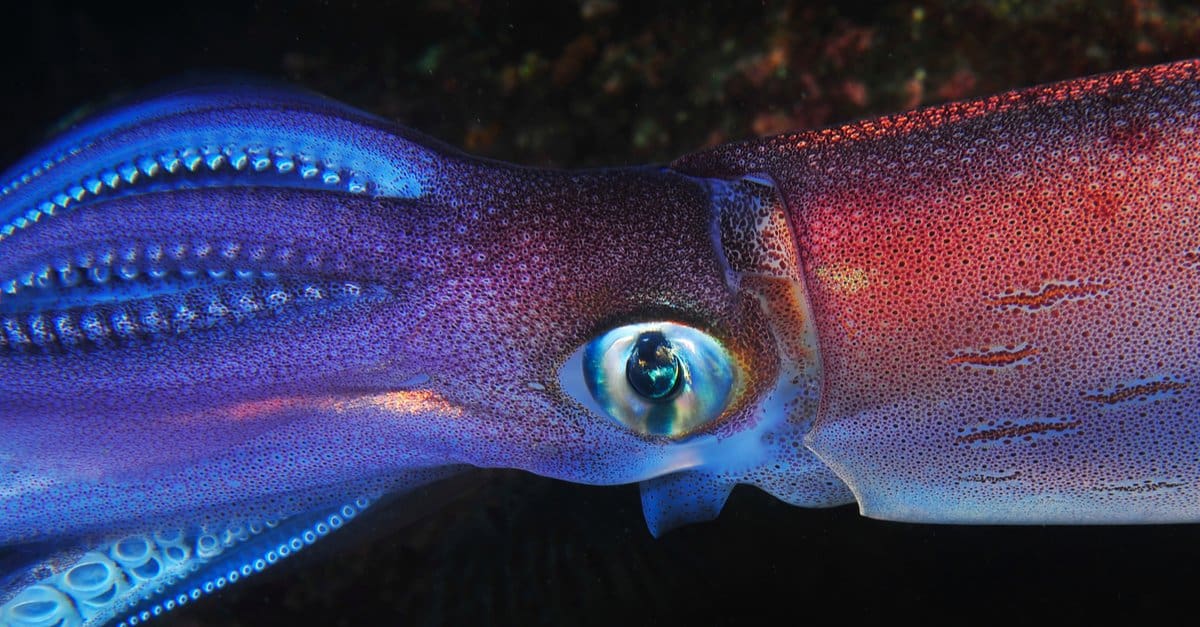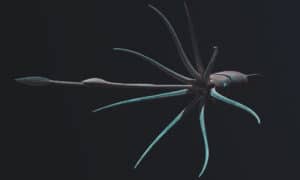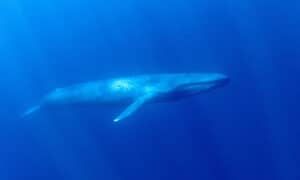True to their name, giant squid (Architeuthis dux) are enormous and mysterious creatures. Unlike large land animals, researchers have limited information on giant squid because of their homes in the deep dark depths of the ocean.
Giant squid live much farther from the surface of the ocean than humans can travel — even in a submarine. Still, we have enough information to compare the size of these creatures to other animals and objects. So just how big do giant squid get?
Types Of Giant Squid
Giant Squid live in the vast, deep ocean and are usually only able to be studied when their carcasses wash up on shore. For this reason, there is no consensus on how many species of giant squid exist.
Some experts argue that there are nearly 17 species. Others believe that there is really only one species of giant squid and that the giant squid found in different oceans are not really genetically different from each other.
In his book Cephalopods: A World Guide (2000), Mark Norman has the following to say:
The number of species of giant squid is not known, although the general consensus amongst researchers is that there are at least three species, one in the Atlantic Ocean (Architeuthis dux), one in the Southern Ocean (A. sanctipauli) and at least one in the northern Pacific Ocean (A. martensi).”
Cephalopods: A World Guide

Giant squid weren’t photographed in their natural habitat until the 21st century.
©InnovationWorld/Shutterstock.com
Size of Giant Squid
Since giant squid are so elusive, it’s hard to gauge an “average” size for these creatures. However, research we do have suggests an average length of around 36 feet from the top of their heads to the end of their tentacles. That’s about the same length as a standard school bus.
Giant squid may weigh anywhere from 330-660 pounds on average, with females sometimes weighing nearly twice as much as males.
It’s important to note the limited nature of our information on giant squid. While some researchers and scientists have managed to successfully film and take photos of a giant squid in its natural habitat, getting this footage is no small feat. A giant squid’s natural habitat happens to lie 1,650-3,300 below the ocean’s surface, where no amount of sunlight can reach.
Giant Squid Comparison to a Human
Giant squid are seven times as large in size as humans. These creatures also have the largest eyes in the animal kingdom. But if the deep sea is so dark, why do giant squid need eyes at all?
The Smithsonian Institute states that this creature’s large eye may help them see larger shadowy shifts in the ocean’s depths, which could help them to avoid larger predators. A giant squid’s eye is up to 10 inches in diameter. That’s about the size of a dinner plate — or a human head!
Fans of the ocean may wonder if these creatures are dangerous to humans. However, giant squid live too deep in the ocean for even the most experienced diver to encounter them in their natural habitat.
On very rare occasions, giant squid have been encountered closer to the ocean’s surface, such as in this video from AFP News Agency. However, it is believed that giant squid that travel near the ocean’s surface are likely very ill or dying.

Giant squid are seven times as large as humans, but humans can’t dive deep enough to observe them in their natural habitat.
©san4ezz/Shutterstock.com
How Big Are Giant Squids When They Are Born?
Information on adult giant squid is limited, and the same goes for their reproductive patterns and babies. Like other species of squid, these creatures lay eggs, which they keep close in an egg mass until the squid babies hatch.
An article from Tech Times reports information on giant squid babies observed off the coast of Japan by researchers from the Institute of Natural and Environmental Sciences at the University of Hyogo.
According to the outlet, back in 2013, a fisherman caught three giant squid babies, two of which were unfortunately dead. Experts were later able to confirm that the specimen were in fact baby giant squid. The babies varied in size from 5.5-13 inches and weighed less than a pound.
The Largest Giant Squid Ever Recorded
The largest giant squid ever recorded by scientists measured 43 feet long and may have weighed nearly a ton. Other notable giant squids have been observed through video footage, photography, and even by pulling the creature to the surface.
The First Live Giant Squid Photographed
In 2004, researchers took some of the first photographs of a live giant squid in its natural habitat. Tsunemi Kubodera of the National Science Museum of Japan and Kyoichi Mori of the Ogasawara Whale Watching Association worked together to drop a line baited with squid and shrimp 900 m off the Ogasawara Islands in the North Pacific.
According to The Royal Society, the line was also equipped with a camera and flash. The researchers recovered one of the squid’s tentacles, which snagged on the line. This tentacle confirmed that the creature photographed was in fact a giant squid and led researchers to believe that the giant squid was over 26 feet long.

Giant squid have an enormous eye that helps it avoid predators.
©Rui Palma/Shutterstock.com
Giant Squid Pulled to the Surface
In 2006, researchers with Japan’s National Science Museum dropped bait from a research vessel off the Ogasawara Islands. According to the Smithsonian Museum, the research team managed to pull a 24-foot giant squid to the surface and observe the living creature.
Video Footage of a Live Giant Squid
The first video footage of a live giant squid in its natural habitat wasn’t recorded until about 10 years ago. According to ABC News, it took a Japanese film crew (NHK) hundreds of tries to finally nab the footage for a Discovery Channel Special.
Even more recently, a giant squid was filmed in US waters for the first time. A team led by Edith Widder used a silent optical lure (dubbed the Medusa) to capture footage of one of these creatures deep below the surface in the Gulf of Mexico. CBS Miami reports that the 20-foot giant squid was filmed 100 miles off New Orleans.
Is a Giant Squid Bigger Than a Blue Whale?
The largest animal on earth and in the sea is the blue whale. So how do these mammals compare to the giant squid? Blue whales are much larger in size than giant squid. These creatures can be 80-100 feet long and weigh 100 tons. That’s the same length as 2 and a half school buses and the same weight as 4-5 buses.
Blue whales do not live as deep as giant squid. In fact, they typically don’t dive more than 100m in depth, so they are much easier to observe than giant squid. Blue whales have even been known to lift their entire bodies out of the water.

Blue whales swim near the shore when a predator is nearby.
©Andrew Sutton/Shutterstock.com
Are Giant Squid Bigger Than Colossal Squid?
Giant squid and colossal squid (Mesonychoteuthis hamiltoni) might sound like different names for the same creature, but the two are actually distinct species. Unlike giant squid, which are thought to be found all around the world, colossal squid only live in arctic seas and habitats, at depths of over 3,000 feet.
In general, giant squid are longer, with some measuring between 40-50 feet. Colossal squid max out at around 30-40 feet in length. However, the colossal squid is typically much heavier because of the size of their mantle and body. Colossal squid have a shorter and stouter body and are wider than giant squid.
The photo featured at the top of this post is © Allexxandar/Shutterstock.com
Thank you for reading! Have some feedback for us? Contact the AZ Animals editorial team.







